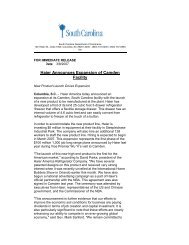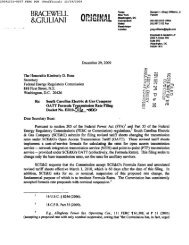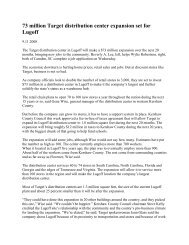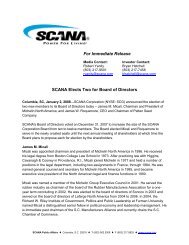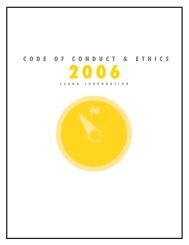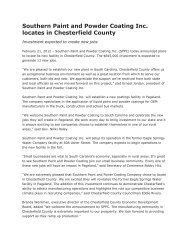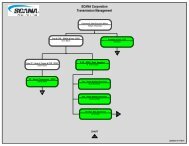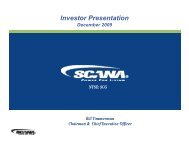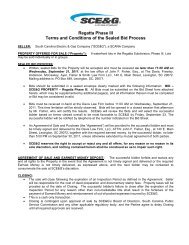10-K - SCANA Corporation
10-K - SCANA Corporation
10-K - SCANA Corporation
Create successful ePaper yourself
Turn your PDF publications into a flip-book with our unique Google optimized e-Paper software.
Table of Contents<br />
The EPA is conducting an enforcement initiative against the utilities industry related to the NSR provisions and the new<br />
source performance standards of the CAA. As part of the initiative, many utilities have received requests for information under<br />
Section 114 of the CAA. In addition, the DOJ, on behalf of EPA, has taken civil enforcement action against several utilities. The<br />
primary basis for these actions is the assertion by EPA that maintenance activities undertaken by the utilities at their coal-fired power<br />
plants constituted “major modifications” which required the installation of costly BACT. Some of the utilities subject to the actions<br />
have reached settlement.<br />
To date, SCE&G and GENCO have received and responded to Section 114 requests for information related to Canadys,<br />
Wateree and Williams Stations. The current state of continued DOJ civil enforcement is the subject of industry-wide speculation, and<br />
it cannot be determined whether the Company will be affected by the initiative in the future. The Company believes that any<br />
enforcement action relative to its compliance with the CAA would be without merit. The Company further believes that installation of<br />
equipment responsive to CAIR previously discussed will mitigate many of the alleged concerns with NSR.<br />
Water Quality<br />
The CWA provides for the imposition of effluent limitations that require treatment for wastewater discharges. Under the<br />
CWA, compliance with applicable limitations is achieved under a national permit program. Discharge permits have been issued and<br />
renewed for all of SCE&G’s and GENCO’s generating units. Concurrent with renewal of these permits, the permitting agency has<br />
implemented a more rigorous program of monitoring and controlling discharges, has modified the requirements for new cooling water<br />
intake structures, and has required strategies for toxicity reduction in wastewater streams. The EPA has said that it will issue a rule by<br />
mid-2012 that modifies requirements for existing cooling water intake structures. The Company is conducting studies and is<br />
developing or implementing compliance plans for these initiatives. Congress is expected to consider further amendments to the CWA.<br />
Such legislation may include limitations to mixing zones and toxicity-based standards. These provisions, if passed, could have a<br />
material impact on the financial condition, results of operations and cash flows of the Company, SCE&G and GENCO. The Company<br />
believes that any additional costs imposed by such regulations would be recoverable through rates.<br />
Hazardous and Solid Wastes<br />
The EPA has stated its intention to propose, in late 2012, new federal regulations affecting the management and disposal of<br />
CCRs, such as ash. Such regulations could result in the treatment of some CCRs as hazardous waste and could impose significant<br />
costs to utilities, such as SCE&G and GENCO. While the Company cannot predict how extensive the regulations will be, the<br />
Company believes that any additional costs imposed by such regulations would be recoverable through rates.<br />
The Nuclear Waste Act required that the United States government accept and permanently dispose of high-level radioactive<br />
waste and spent nuclear fuel by January 31, 1998. The Nuclear Waste Act also imposed on utilities the primary responsibility for<br />
storage of their spent nuclear fuel until the repository is available. SCE&G entered into a Standard Contract for Disposal of Spent<br />
Nuclear Fuel and/or High-Level Radioactive Waste with the DOE in 1983. As of December 31, 2011, the federal government has not<br />
accepted any spent fuel from Summer Station Unit 1 or any other nuclear generating facility, and it remains unclear when the<br />
repository may become available. SCE&G has on-site spent nuclear fuel storage capability until at least 2017 and expects to be able to<br />
expand its storage capacity to accommodate the spent nuclear fuel output for the life of Summer Station Unit 1 through dry cask<br />
storage or other technology as it becomes available.<br />
The provisions of CERCLA authorize the EPA to require the clean-up of hazardous waste sites. In addition, the states of<br />
South Carolina and North Carolina have similar laws. The Company maintains an environmental assessment program to identify and<br />
evaluate current and former operations sites that could require environmental clean-up. In addition, regulators from the EPA and other<br />
federal or state agencies periodically notify the Company that it may be required to perform or participate in the investigation and<br />
remediation of a hazardous waste site. As site assessments are initiated, estimates are made of the amount of expenditures, if any,<br />
deemed necessary to investigate and remediate each site. These estimates are refined as additional information becomes available;<br />
therefore, actual expenditures may differ significantly from the original estimates. Amounts estimated and accrued to date for site<br />
assessments and clean-up relate solely to regulated operations. Such amounts are recorded in deferred debits and amortized, with<br />
recovery provided through rates. The Company has assessed the following matters:<br />
44



